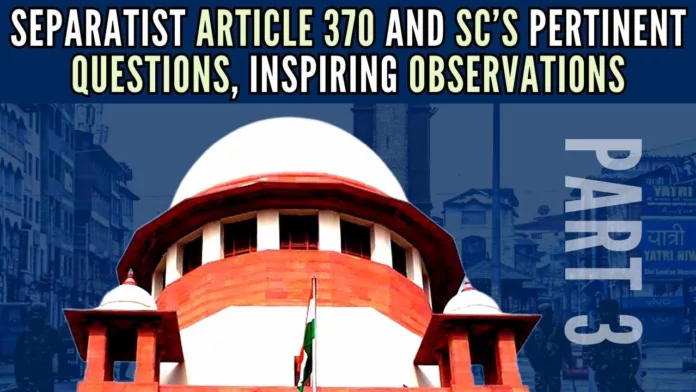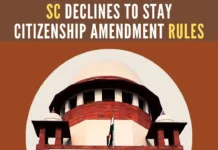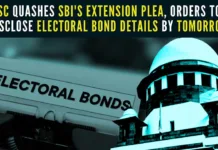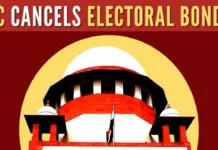
The previous 2 parts of the article can be accessed here Part 1, Part 2. This is the Third part
SC hearing on Article 370 abrogation
Hearing on seditious Article 370 and reorganization of J&K State by the 5-judge constitutional bench headed by Chief Justice Chandrachud continued on August 22, 23, and 24. The petitioners’ lawyers – Sanjay Parikh, P C Sen, Dinesh Dwivedi, C U Singh, Nitya Ramakrishnan, Meneka Guruswamy, Gopal Shankarnarayan and Manish Tiwari – put forth their arguments against the August 5-6, 2019 reforms as introduced by the Narendra Modi government to integrate the whole region of Jammu, Kashmir and Ladakh completely into India and satisfy the urges of the Ladakhi Buddhists.
There was hardly any difference between what they argued and what the petitioners’ other advocates had argued between August 2 and 17. The only difference perhaps was that Sanjay Parikh, P C Sen, Dinesh Dwivedi, CU Singh, Nitya Ramakrishnan, Meneka Guruswamy, Gopal Shankarnarayan, and Manish Tiwari couched their arguments in a somewhat different manner. No wonder then that the Chief Justice had to say that “the bench is also reaching a level of mental saturation where now we need answers from the Centre”[1]. Besides, the Chief Justice asked: “If petitioners want Supreme Court to assess government’s ‘wisdom’ in repealing Article 370”. And a report in The Hindu (Aug 22) in this regard said: “The SC appeared unenthusiastic to accept an ‘invitation’ to judicial review the ‘wisdom’ behind the Union government’s decision to abrogate Article 370.”
Parikh’s sovereignty concept flawed
Advocate Parikh’s arguments read like this: “The people of (Jammu and) Kashmir came together and gave themselves a manifesto. They said they want a Constitution and economic plan for (Jammu and) Kashmir. The sovereignty rests with the people and they express their sovereignty in a specific way. This sovereignty was translated into the J&K Constitution. When there is a written Constitution, the written Constitution becomes supreme”[2].
Besides, Parikh said: “The 1954 Presidential Order was issued after the concurrence of the (J&K) Constituent Assembly and thus the subsequent Presidential Orders were issued under the assumption that (J&K) Constituent Assembly approval pre-exists and thus how else can there be a concurrence. Article 356 was brought in by virtue of Constitutional Order 71 in 1965. Article 357 was not adopted. It was only Article 356. One question that arises is what is the implication of Article 357 not being there? Why did they (the Union government) resort to (Section) 92 (of the J&K Constitution of 1957)? Why not rely only on 356? The answer is that because after the proclamation, on the next date, he (Governor Satya Pal Malik) dissolved the (J&K) Assembly by resorting to Section 53(2)(b) (of the J&K Constitution) which could not have been done without aid and advice of the council of ministers. 92 acts in a particular sphere and 356 acts in a different sphere altogether. You can reconcile it but they operate in different fields. Once you exercise power under 92 and say we’re dissolving…”[3].
CJ Chandrachud virtually rejected Parikh’s arguments
Chandrachud’s observation: “So Article 357 is not made applicable. And, therefore, no parliament can assume to itself the power of the state legislature to enact law and cannot delegate it further to the President”[4].
Dwivedi’s people sovereignty argument untenable
Advocate Dinesh Dwivedi started by saying that “I am arguing somewhat differently from what my friends have argued”; that “they (lawyers like Sibal) want some part of Article 370 to survive”; and that “my argument is that nothing survives”; and that “all the powers conferred under Article 370 ceased to operate once the Constitution of J&K was enacted.”
Dwivedi’s basic arguments: “The standstill agreement was a precondition for the Instrument of Accession contrary to other states which had merged with the Dominion of India through merger agreements thereby ceding all powers…It ceded at a different time as an independent state or a nation…and it was different in the sense that it did not merge, unlike the other states…The accession of (Jammu and) Kashmir rested on the condition that it was not bound by the Constitution of India or any other future Constitution and that its internal sovereignty would always rest with the rulers…Our basic theme is that (Jammu and) Kashmir was different both in terms of accession to the Dominion of India where it ceded at a different time as an independent state or a nation…Sovereignty is a variable concept with two components – internal and external sovereignty. That merely Kashmir had ceded external sovereignty, it does not mean that Internal sovereignty was also ceded…Article 1 of the Constitution does not mean that the internal sovereignty of J&K was ceded…Article 370 ceases to operate once the Constitution of J&K was enacted in 1957…”
Dwivedi also referred to Constituent Assembly debates by Kashmir Affairs Minister, Gopalaswami Ayyangar, and said; “Article 370 was intended to be an interim agreement until the J&K Constitution is enacted…’ The Constituent Assembly is always regarded by us as the most august Assembly. They say (Jammu and) Kashmir should frame their own Constitution, they could not have implied something else…All provisions of concurrence and consultation were interim till the Constituent Assembly was formed…We always say that our framers were very wise. But when it comes to the commitments they made – we forget it…All the powers conferred under Article 370 ceased to operate when the constitution was made. In this context, we have to keep in mind the object of Article 370 and the commitments made…Status of (Jammu and) Kashmir was a Part D State when the Constitution was adopted. Yet, in 370, Article 268 was excluded. That speaks volumes about the autonomy of the state. Initially, all Indian States were promised that they’d have their own constitutions. But through negotiations, this was taken up”[5].
In addition, Dwivedi said: “When the Article was framed, Jammu and Kashmir was in turmoil and the only legal entity was the state government and, therefore, the provision said there should be ‘consultation and concurrence’ on the matters related to Union and Concurrent list and those which do not fall under the Instrument of Accession. The Constituent Assembly was about to be set up. Hence, all the decisions that were taken in consultation and concurrence with the state government were to be placed before the Constituent Assembly of J&K. Therefore, Article 370 was a temporary provision…Looking at the provision and the Constituent Assembly debates, it can be clearly inferred that Article 370 was temporary and ceased to exist after January 1957.”
Besides, insisting that Article 370 was not a permanent feature of the constitution and countering the view of other lawyers who emphasized that Article 370 had become permanent, Dwivedi said: “This is what is creating a problem. Perhaps our thinking in the manner which we have been tuned to think for the past 70 years is that there should be a One Nation-One Constitution. But where is that prescribed? It should be prescribed in the constitution which does not say so…Interpreting Article 370 to be a ‘temporary provision’ would mean that we are assigning it a meaning dehors the context… Article 238 of the Constitution cannot apply in relation to Article 370…(Note: The subject of Article 268 was the applicability of the provisions of Part VI to the states listed in Part B of the First Schedule of the Indian Constitution. It was revoked by the Constitution (Seventh Amendment Act, which was passed in 1956.)…The law, as I understand, is that however long a past practice is if it is constitutionally illegal, it cannot be justified. What I am trying to show is the intent of our Constitution framers. We cannot read Article 370 dehors (other than) the intent is my question.”[6].
SC bench’s serious questions, observations
CJ Chandrachud observed: “The consequence of the argument will be that the Constitution of India and its application to J&K would ‘stand frozen as of January 26, 1957’. Therefore, no further development in Indian Constitutional law can at all apply, according to you (Dwivedi), to the State of J&K after 1957. How can that be acceptable?” The CJ further asked: “Can the court say that a speech made by a member (Ayyangar) of the Constituent Assembly, however weighty, represented the commitment of India to J&K?” He observed that “this will have a bearing on the interpretation of the Constitution.”
The CJ didn’t stop just here. He further said: “There are no provisions in the Indian Constitution that bars its applicability to J&K…Article 5 of the J&K Constitution says that the legislative and executive powers of the state would extend to all matters except those with respect to which Parliament has the power to make laws…”
In fact, the bench told Dwivedi that “what was being submitted (by him) was contrary to arguments advanced by others opposed to the abrogation as they said that the provision had acquired permanent status after the term of the State’s Constituent assembly ended.” “You are asking us to read what is not there in Article 370. Your submission is that it will be frozen after the Constituent Assembly of J&K frames the constitution but that does not appear to be following. We have to look at the Constituent Assembly debates in a manner in which Article 370 was framed,” the bench also said.
Justice Kaul’s intervention
Addressing Dwivedi, Justice S K Kaul said: “You are saying that all that happened for last few decades is wrong, no one understood the Constitution…It is a little difficult to accept that the Constituent Assembly debates amounted to an assurance that Article 370 dissolved itself…As it (Article 370) has inadvertently remained on the statute, I feel very strongly about Article 370…I am putting to you the consequences of what would happen if we accept what you are saying…I thought you (Dwivedi) said that 370 didn’t exist. That it should be read in a manner that 370 was intended to dissolve itself after Constituent Assembly completing…We read an intent based on debates. How it transpired and worked out after that – what about that?”
“According to you (Dwivedi), Article 370 was a defunct provision and no purpose was served to have it,” Justice Kaul said. He further said: “Yet the provision continued to be there in the Indian Constitution. Constitution Orders (orders applying provisions of the Indian Constitution to J&K) have been issued pre-1957 and post-1957. Yet nobody thought about removing it. The association of people with Article 370 was negatory and, hence, nothing survives. This is your argument”[7].
Sen’s communal approach
Questioning the invocation of Article 356, Advocate P C Sen, inter-alia, said: “The region (J&K) consisted of a Muslim majority. The population had a choice between going to Pakistan or India. Either be a majority in Pakistan or be a minority in India. They (Muslims) chose the latter. When there is a conscious choice is made in this matter, it is all the more a reason to strictly construe…Asymmetrical federalism provides protection against majoritarianism. Our constitution is also anti-majoritarianism…What are the limits of a constitutionally vested power? Liberty ends where the other man’s nose begins. So the moment there is a fundamental constitutional principle, there must be a limit…If one were to do away with these (Article 370), which involves historically a religious minority, that would be a regressive step…There is no material on why Article 356 was imposed. But the material that already exists on record –it says that peace, security, effective governance based on rule of law, and upholding principles of equality, J&K rises above a number of states…”[8].
Singh invoked the Bengal partition in the 1905, 1919, and 1935 Acts
Journalist Prem Shankar Jha’s lawyer, C U Singh, termed the reorganization of J&K illegal and unconstitutional. He started by saying that “my arguments would focus on the J&K Reorganization Act, 2019” and, among other things said: “No power has been provided under Article 3 of the Constitution to convert a state into a UT…States can be interchanged with UTs under Article 3 of the Constitution due to the Constitution (Eighteenth Amendment Act, 1966 but the Eighteenth Amendment was not applicable to J&K on August 5, 2019 (the day the bill was passed in the Rajya Sabha)…If this interpretation of Article 3 is upheld, then it is the thin end of the wedge for democracy and federalism and the country as a whole…Because then any party in power at the Centre, which also happens to be a party in power in a state, can just convert the state by a simple majority in the state legislature and a simple majority in the Parliament…”
Singh also referred to the SC’s ruling in S R Bommai V Union of India to show that Article 356 of the Constitution (President’s Rule) must be used sparingly and under exceptional circumstances. Undoubtedly, the breakdown of the constitutional machinery in a state does give rise to a situation of emergency…Keeping aside Article 370, the framework around reorganization is crucial for the people of J&K. If reorganization under Article 3 is upheld, it will threaten democracy and federalism for the country…Right from the Government of India Act of 1919, the progression has consistently been towards greater self-governance in the form of statehood. I submit that the conversion of the state into a UT if at all it could be done, could be done only under Article 368 because it clearly impinges on at least 6-7 provisions. So it would require both a special majority and ratification by more than 50%…The Exercise which has been done for Ladakh and J&K is outside the purview of Article 3…[9].
“The state comes with property, lands, consolidated funds, rights, contracts – it has absolute sacrosanct powers under Article 73 read with Article 2…For Ladakh, and J&K both –the exercise that has been done is one that is outside the purview of Article 3, even if it was rightly done. This is not the scope of Article 3…Himachal Pradesh with its 30 states still was not viable. So it was part of C states. Part C states also included Indian states which were not able to be merged into viable states. For instance, HP consisted of 30 Indian States. But because the province of Punjab came almost to the edge of Shimla and they automatically went as Part A state… Part I has to be read conjointly and when you read it conjointly no power is provided under Article 3 to convert a state into UT notwithstanding the two explanations,” Singh also said[10].
To make his point, Singh further said: “History of Articles 3 and 4 emanating from the (London enacted communal and divisive) 1919 and 1935 Government of India Acts shows that the power to alter boundaries, change names, etc. was always used to increase self-representation and democratic self-government. There was no case of retrogradation. Today, there are only 6 UTs if you keep aside J&K. Even Dadra and Nagar Haveli and Daman and Diu have been merged into one in 2020. They have been made into one UT…In 1905, Lord Curzon split the province of Bengal. That led to a tremendous backlash against the British Raj. In 1911, Lord Harding was compelled to rescind that move…”[11].
Chandrachud’s questions, observations
Addressing Singh, CJ Chandrachud said: “Part C states that were the erstwhile Chief Commissioner’s provinces and Part D states that were the other states” and asked “would it be correct to say that when the constitution was adopted on Jan 26, 1950, the territories were comprised of part A states which consisted of erstwhile governor’s provinces, Part B states which were Indian States that acceded to India, Part C states that were the erstwhile Chief Commissioner’s provinces and Part D states that were other states?” “So we must look at what the position was in the Government of India Act, how that transformed into the constitution. That will give us an idea of how the UTs were created. UTs came into being with the Seventh Amendment in 1956. That abrogated the distinction between Part A, B, and C states and brought the entire India into states and UTs,” the Chief Justice said[12].
Besides, the Chief Justice asked “if the conversion of the state into a UT is severable from abrogation of Article 370 itself?[13].
To be continued…
Note:
1. Text in Blue points to additional data on the topic.
2. The views expressed here are those of the author and do not necessarily represent or reflect the views of PGurus.
Reference:
[1] Article 370 hearing updates: ‘We need answers from the Centre’, says CJI – Aug 22, 2023, India Today
[2] Supreme Court hearing on Article 370 abrogation | Day 8 – Aug 22, 2023, The Hindu
[3] Article 370 hearing updates: ‘We need answers from the Centre’, says CJI – Aug 22, 2023, India Today
[4] Article 370: No provision in Constitution that bars its applicability to J&K, says CJI – Aug 22, 2023, India Today
[5] Article 370 was never intended to be permanent: SC – Aug 24, 2023, The Indian Express
[6] Supreme Court terms as “unacceptable” contention that Article 370 ceased to operate after 1957 – Aug 22, 2023, ToI
[7] Supreme Court hearing on Article 370 abrogation | Day 8 – Aug 22, 2023, The Hindu
[8] Article 370 hearing updates: ‘We need answers from the Centre’, says CJI – Aug 22, 2023, India Today
[9] Supreme Court hearing on Article 370 abrogation | Day 8 – Aug 22, 2023, The Hindu
[10] Article 370 Case : Live Updates From Supreme Court [Day 8] – Aug 22, 2023, Live Law
[11] Article 370: No provision in Constitution that bars its applicability to J&K, says CJI – Aug 22, 2023, India Today
[12] Article 370 Case : Live Updates From Supreme Court [Day 8] – Aug 22, 2023, Live Law
[13] Supreme Court hearing on Article 370 abrogation | Day 8 – Aug 22, 2023, The Hindu
PGurus is now on Telegram. Click here to join our channel and stay updated with all the latest news and views
For all the latest updates, download PGurus App.










